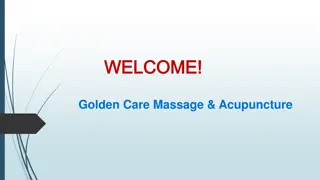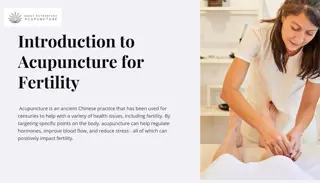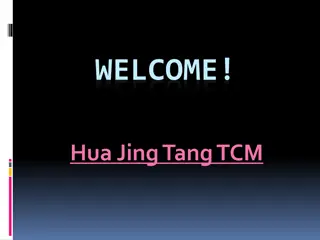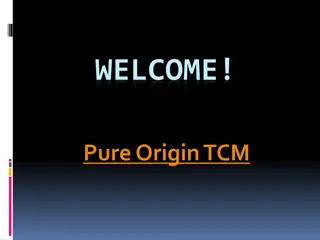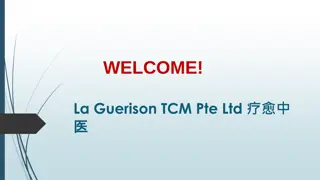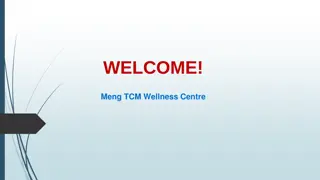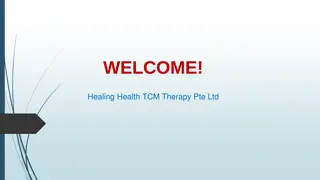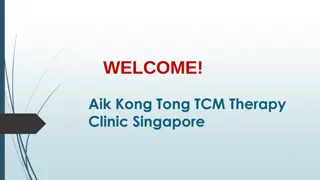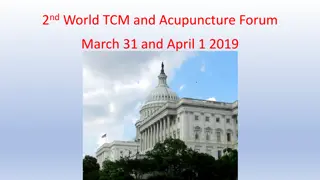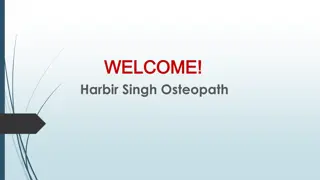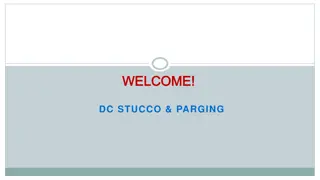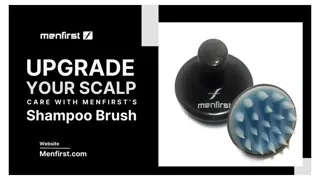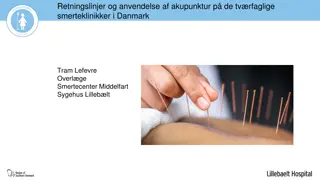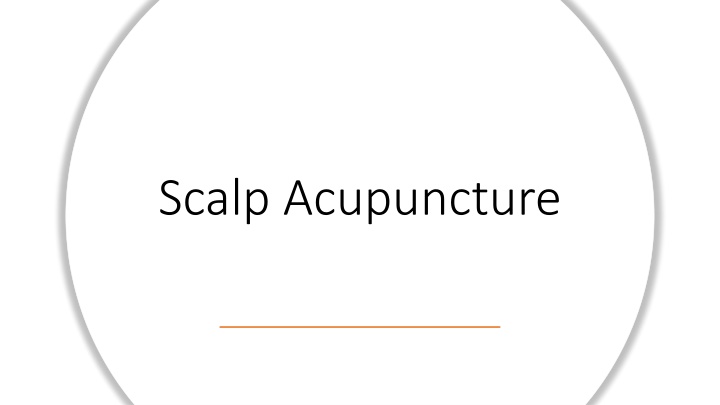
Scalp Acupuncture Therapy and Meridian Systems
Discover the fascinating therapy of scalp acupuncture, which involves needling specific areas on the scalp to treat various diseases. Learn about the ancient wisdom behind this practice and how it combines traditional acupuncture techniques with modern physiology. Explore the intricate meridian system, a vital network in the human body connecting internal organs for holistic healing.
Download Presentation

Please find below an Image/Link to download the presentation.
The content on the website is provided AS IS for your information and personal use only. It may not be sold, licensed, or shared on other websites without obtaining consent from the author. If you encounter any issues during the download, it is possible that the publisher has removed the file from their server.
You are allowed to download the files provided on this website for personal or commercial use, subject to the condition that they are used lawfully. All files are the property of their respective owners.
The content on the website is provided AS IS for your information and personal use only. It may not be sold, licensed, or shared on other websites without obtaining consent from the author.
E N D
Presentation Transcript
The scalp acupuncture is a therapy applied by needling the specific areas of the scalp to treat diseases. It is invented and developed by combining the theories and techniques of traditional acupuncture and the knowledge of modern physiology and anatomy of the nervous system on the basis of repeated scientific research and clinical practice for many years. The meridian system is the most important system in the human body. When we use acupuncture needles it can cure various diseases and adjust deficiency or excess of human body. It is a huge network distributed all over the body to connect the internal organs.
With the external trunk and limbs and converges into the spinal cord and stops at the brain. The central part comprises the brain and the spinal cord in the skull. The spinal cord in spinal canal is called Dumai (governor vessel) The peripheral part can be further divided into the part to connect the trunk and limbs and the part to connect the internal organs. The part connecting the trunk and limbs comprises the meridians and collaterals from the brain and spinal cord and are distributed all over the trunk and limbs of the body and the part linking the internal organs mainly refers to the chong mai (thoroughfare vessel) and Ren mai (conceptional vessel).
The ancient physicians already know that the qi of the head, chest, abdomen and legs each has its own path to flow, that the qi of the head flew to brain. It indicates that the head and brain have particular relationship with each other. Therefore, the acupuncture over the scalp should certainly produce satisfactory therapeutic result. This forms the theoretical basis of scalp acupuncture used to treat diseases of the brain. Another inspiration for the invention of scalp acupuncture is from the therapeutic results obtained from stimulating the Mu acupoints, which are the locations where the qi of internal organs converges and assembles. They are also taken as Special acupoints used to treat diseases of the internal organs.
Each of the 12 internal organs has its specific mu point at the chest and abdomen region, although not all of them lie on the meridians related to their corresponding internal organs. The reason is that the mu points are all located over or close to their corresponding organs. Although the mu point of Stomach (Ren 12) has no relation with the stomach meridian, it lies directly over the stomach.
The mu point of stomach (Ren 12), although it has no relation with the stomach meridian, lies directly over the stomach. The mu point of LI (st 25) The mu point of pericardium (Ren 17) The point of Spleen (LR 13) The mu point of kidney (GB 25) The mu point of small intestine (Ren 4) The mu point of sanjiao (Ren 5) Those mu point although no relation with their own meridians but we used them to treat their organs to cure diseases. Therefore, those mu points may produce more remarkable effects in treating diseases of the correlated organs than other acupoints on the corresponding meridians.
So, therapeutic results can be achieved by needling the mu points at the body surface corresponding to their internal organs to cure the diseases of the underlying organs, so better therapeutic results should also be made in treating cerebral diseases by needling simulation applied at the corresponding locations of the scalp. This idea support the usage of scalp acupuncture to treat cerebral disease. The inspiration for the invention of scalp acupuncture is on going with continued researches until professor Jiao Shunfa, neurosurgeon, combined a modern understanding of neuroanatomy and neurophysiology with traditional technique of Chinese acupuncture to develop new tool for affecting the functions of central nervous system.
First of all, a lot of researches have been done from 1950 to 1970s. They proved that scalp acupuncture can: 1. Dilate central cortical blood vessels 2. Improve the blood supply of diseased cortex 3. Promote the metabolism of brain cells. 4. The expression of neurotrophic factors, and specially actuate specific motor function areas of cerebral cortex. Researches continue to emphasize how: 1. Brain can adapt and regain its ability to reroute signals 2. Brain cells can only change its functions but can take over the function of nearby damaged cells. 3. Extensive and repeated clinical applications have proved that needling stimulation at the scalp over different areas of cerebral cortex is effective in treating the symptoms and physical signs of cerebral lesion.
In 1972 Dr Jiao Shun Ja named this new therapeutic technique Scalp acupuncture that his researches depend on extensive knowledge of both the past and present theory of Chinese. Repeated experience proves that needling stimulation at the scalp over the postcentral and precentral gyruses is effective to treat sensory and motor disturbance. The postcentral gyrus is the sensory area of the cerebral cortex to control the sensation of human body, and the precentral gyrus is the motor area to control the movement. The news that needling stimulation at scalp to cure paralysis was soon spread. Extensive and repeat clinical applications have proved that needling stimulation at the scalp over the different functional areas of the cerebral cortex is also effective in treating the symptoms and physical signs of cerebral lesions.
Ancient Chinese physicians discovered the nervous system in human body 2500 years ago. At that time, it was called meridian system (meridians and collaterals). It is a huge and complicated system to connect the internal organs and the external trunk and limbs. All the meridians converge into the spinal cord (spinal canal) and end at the brain. The meridian system can affect and determine the survival or death of human beings, and can be used to treat hundreds of diseases and adjust the deficiency and excessiveness of the human body. The scalp Acupuncture was invented and developed through clinical practice by combining the techniques of traditional acupuncture and the knowledge of modern anatomy and physiology. The stimulating areas over the scalp are defined chiefly according to the location of the functional areas of the cerebral cortex. For example, since the precentral gyrus is a motor centre of the cerebral cortex, this area over the scalp is defined as the motor area.
Location and function of stimulating areas: To define the stimulating areas, it is necessary to establish marking lines over the scalp according to some demarcations on the surface of the skull. Anetrio-posterior median line: This median line is drawn from the midpoint between the eyebrows to the lower border of external occipital tuberosity. Supraciliary-occipital line: This line is drawn from the midpoint of upper border of eyebrow to the tip of external occipital tuberosity.
Motor area Location: The upper end of motor area lies 0.5 cm behind the midpoint of anterio-posterior median line and the lower end lies at the intersect of the supraciliary-occipital line and anterior border of temple. Function: Function: Upper one Upper one- -fifth: to treat paralysis of the contralateral lower limb fifth: to treat paralysis of the contralateral lower limb Middle two Middle two- -fifths: To treat paralysis of the contralateral upper limb fifths: To treat paralysis of the contralateral upper limb Lower two Lower two- -fifths (first speech area): To treat facial paralysis, motor aphasia, dripping of saliva and disturbance of phonation fifths (first speech area): To treat facial paralysis, motor aphasia, dripping of saliva and disturbance of phonation.
Sensory area Location: it is parallel to and 1.5 cm behind the motor area. Function: Function: Upper one Upper one- -fifth: to treat pain, numbness and abnormal sensation of the contralateral side in the back and leg, occipital headach fifth: to treat pain, numbness and abnormal sensation of the contralateral side in the back and leg, occipital headache, pain of the neck and nape, and tinnitus. the neck and nape, and tinnitus. Middle two Middle two- -fifths: to treat pain, numbness and abnormal sensation of the contralateral arm. fifths: to treat pain, numbness and abnormal sensation of the contralateral arm. Lower two Lower two- -fifths: to treat pain, numbness and pain of the contralateral side in the head and face. fifths: to treat pain, numbness and pain of the contralateral side in the head and face. e, pain of
Controlling area of chorea and tremor Location: It is parallel and 1.5 cm to the front of the motor area. Function: To treat involuntary movement and tremor of contralateral limbs.
Vascular dilation and constriction area Location: It is parallel and 1.5 cm to the front of the chorea and tremor controlling area. Function: to treat essential hypertension and cortical-edema.
Dizziness and auditory area Location: Taking the point 1.5 cm directly above the tip of ear auricle as the midpoint of a horizontal line, which is 4 cm in length. This is the dizziness and auditory area. Function: to treat ipsilateral dizziness, tinnitus, auditory vertigo, cortical impairment of hearing and auditory hallucination.
Second speech area Location: to draw a parallel line along the anterio-posterior median line through the parietal tuber and take a section of 3 cm in length from the pint 2 cm behind the tuber. Function: to treat anomic aphasia.
Third speech area Location: to draw an extending line backward from the midpoint of dizziness and auditory area, 4 cm in length. Function: to treat sensory aphasia.
Application area Location: To draw a line from parietal tuber to the centre of mastoid process and draw two more lines from the same origin of the first line at the tuber, one in front of the first line and another one behind the first line with an angle of 40 degree between the first line and each of the latter lines, all 3 cm in length. Function: To treat parectropia (fine movement).
Motor and sensory area of foot Location : To draw two parallel lines 1 cm beside the anterio-posterior median line, 3 cm in length, from a point 1 cm to the front of the upper end of motor area to a point 1 cm to the back of the upper end of sensory area. Function: To treat pain, numbness and paralysis of the contralateral side of the back and contralateral leg. To treat bed-wetting of babies, cortical frequent micturition, cortical dysuria, cortical incontinence of urination and prolapse of anus by needling stimulation on both sides. To treat frequent and urgent urination due to acute cystitis, thirst, diuresis and increase of water intake due to diabetes mellitus, impotence, emission and prolapse of uterus by needling stimulation on both sides of the reproductive area and this area; to treat irritable colon and diarrhoea due to some other causes by needling stimulation on both sides of the intestine area and this area; to treat oliguria due to rheumatic heart disease by stimulating both sides of the thoracic cavity area and this area; and to treat hyperplasia syndrome of cervical and lumbar vertebrae, contact dermatitis and neurodermatitis by stimulating both sides of the upper two-fifths of the sensory area and this area. Frequent micturition, difficult urination and incontinence of urination caused by the functional disturbance of paracentral lobule due to cerebral arteriosclerosis with deficiency of blood supply in the anterior cerebral artery, cerebral thrombosis or other causes are named as "cortical frequent urination," "cortical difficult urination" and "cortical incontinence of urine" respectively.
Optic area Location: To draw two 4-cm parallel lines one centimetre beside the anterio- posterior median line, one on each side, from the level of external occipital tuberosity upward Function: To treat cortical impairment of vision and cataract.
Balance area Location: To draw two parallel lines, 4 cm long vertically and 3.5 cm beside the median line on both sides, from the level of external occipital tuberosity downward Function: To treat disturbance of body balance due to injury of the cere- bellum.
Stomach area Location: To draw two parallel vertical lines of 2 cm in length directly above the centre of pupils from the anterior hair border (or 6 cm from the level of the midpoint between eyebrows) (Fig. 1-6). Function: To treat the acute and chronic gastritis and pain due to peptic ulcer of stomach and duodenum.
Liver and gallbladder area Location: To extend the stomach area downward for 2 cm Function: To treat pain in the right upper abdomen due to disorders of the liver and gallbladder.
Thoracic cavity area Location: To draw two 4-cm parallel lines between median line and the Function: stomach area on both sides, with 2 cm above and 2 cm below the anterior hairline. To treat allergic asthma, bronchitis, angina pectoris, rheumatic heart disease, paroxysmal supraventricular tachycardia (also effective to some extent to treat palpitation , shortness of breath, edema and oliguria).
Reproductive area Location: To draw two 2-cm vertical lines, parallel from the frontal corner upward Function: To treat functional uterine bleeding. To treat frequent urination and urgent urination due to acute cystitis, extreme thirst, polyuria and increase of water intake due to diabetes mellitus, and impotence, emission and prolapse of uterus by stimulating both sides of the motor and sensory area of foot and this area.
Intestine area Location: To extend the reproductive area on both sides downward for 2 cm Function: To treat pain in the lower abdomen with certain effect.The locations of frontal stimulating areas are defined according to the spread of the needling sensation and therapeutic effects, rather than according to the division of underlying functional areas of the cerebral cortex.
The treatment plan consist of several rounds, each of which are divided to 30 sessions. The first 10 area taken every other day, followed by two weeks rest, then another 10 sessions in the same pattern. Following then is another two weeks rest then 10 sessions again with the same pattern, ending at last with a two month rest. The explained 30 sessions round should be repeated several times, particularly for a child with cerebral palsy. It should be noted that a child s condition improves significantly after mentioned various rounds, with also his dependence on his parents decreasing from 100% before treatment to at most 30% after.
Techniques of Acupuncture: Acupuncture technique is an important factor affecting the therapeutic results. Good acupuncture technique should produce better therapeutic results, cause less side effects and sufferings to the patients, and is highly efficient. Commonly used acupuncture needles nowadays are made of stainless steel, and the handles are wrapped by winding thin copper wire, or aluminium wire. Good needling skills can both reduce the puncture pain and improve the therapeutic effect. The patient should be put in a comfortable posture which makes it easy for the physician to accurately locate the stimulating areas and conveniently manipulate the needles. Usually, the sitting posture is selected for scalp acupuncture. A three-quickness acupuncture was developed by Shung fa, that is, quick insertion, quick manipulation and quick removal of needles. The insertion of needles contains two steps prompt puncture into the skin and the quick push of the needle into the deeper layers of tissue. For the step of prompt puncture, the needle is pinched by the thumb and index finger two centimetres back from the tip. Directed at the targeted stimulating area and with the tips of the thumb and index finger being 5- 10 centimetres above the scalp, the tipoff the needle is promptly punctured through the skin to the subcutaneous or muscular layer from a distance of 10-20 centimetres. For the pushing puncture step, pushing the needle is done with single hand. Having made the needle puncture through the skin, using the tips of the thumb and index finger to pinch the distal half of the needle.
Unfavourable reactions during and after scalp acupuncture: Scalp acupuncture is generally save and does not produce any bad effect in most patients. Yet, it may give rise to some unfavourable reactions in a small number of patients, which include local pain, palpitation, shortness of breath, general discomfort, and edema after treatment. Most of these reactions will disappear a few seconds to several minutes after the needles are removed. For a tiny number of patients who show strong unfavourable and in whom the therapy seems to produce apparent cure, scalp acupuncture may be temporarily discontinued.
Syncope during acupuncture treatment: During acupuncture treatment, if the patients suddenly develop a spell of repeated yawning and their facial complexion changes, this is a premonitory sign of syncope. If syncope really occurs, the patient may show such manifestations as pale complexion, chest distress, palpitation, dizziness, blurred vision, nausea, profuse perspiration and cold limbs. The method to deal with the situation: Needling syncope is due to temporary cerebral ischemia. To cope with the situation, the needles should be immediately remove and patient lay down and given some water to drink. In normal conditions, the needling syncope can be released in several minutes. Safety: we will conduct the following tests on all participants at the screening stage to exclude patients with serious organic lesions. White blood cell count, platelet count, hemoglobin, coagulation function, creatinine, blood urea nitrogen, alanine aminotransferase, aspartate aminotransferase and electroencephalogram examination. Subjects will be requested to report information about adverse events. All adverse events that occur during trial period will be recorded, such as dizziness, sweating, fainting, chest congestion during scalp acupuncture treatment.
Herpes zoster: Herpes zoster is an acute infectious disease affecting first the primary sensory neurons and skin related to them. At the early stage of herpes zoster over the limbs and trunk, the patients usually feel a burning and pricking pain over the cutaneous area covering one or two somatomes innervated by the infected nerve roots along with a hypersensitivity to pain. Selected stimulating areas: Sensory area, and motor and sensory are of foot on both sides. Treatment: scalp acupuncture may produce an effective cur to pain caused by herpes zoster. Of a total of 185 cases of herpes zoster treated with scalp acupuncture, 117 were cured, accounting for 63.24 percent; 47 were greatly relived, accounting for 25.4 percent; 14 were improved, accounting for 7.56 percent; and seven did not see any therapeutic effect, accounting for 3.78 percent.
Headache: Headache is a common symptom. It may be caused by both diseases of the nervous system and diseases of the whole body. Selected stimulating areas: For headache in the parietal region, upper two- fifths of the sensory area on both sides are selected; and for headache in the frontal and temporal region, lower two-fifths of the sensory area on the contralateral side are selected. Generally speaking, for pain on one side of the head, select the sensory area on the opposite side, and for pain on both sides of the head, select the sensory area on both sides. Treatment: scalp acupuncture, applied once a day. Of the 463 cases of headache treated with scalp acupuncture, 236 were cured, accounting for 50.97 percent; 65 were greatly relieved, accounting for 14.03 percent; 134 were somewhat relieved, accounting for 28.94 percent; and 28 did not see any effect at all, accounting for 6.04 percent.
Cerebral palsy: cerebral palsy is described as a group of permanent disorders of movement and posture, causing activity limitation and movement disorder to a a child. Several risk factors are involved in the development of cerebral palsy which can occur during pregnancy, at birth, or after birth. These include maternal infection, premature birth, low birth weight, low distribution of oxygen in blood supply to brain, resulting in abnormalities in brain development, leading to cerebral palsy. There are different types of cerebral palsy including spastic, dyskinetic (abnormal posture tone), hypotonic, atoxic or mix. Scalp and body acupuncture treat the conditions of a child. It improves to a large extent the motor, sensory, equilibrium,speech, hearing and more. As previously illustrated scalp acupuncture decrease child dependency on his parents from 100% to 30% after many rounds of treatment.


